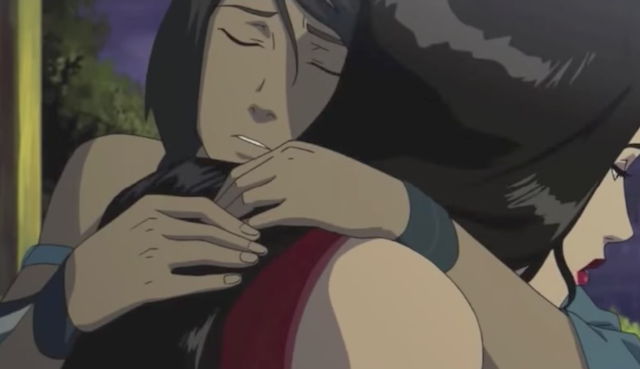
In 2012, an animated children’s film, called “ParaNorman,” featured an openly gay character—a stereotypical jock-type named Mitch Downe—who revealed his sexual orientation at the end of the film saying, “You’re gonna love my boyfriend, he’s like a total chick-flick nut!”
In the same year, an animated children’s television series, called “The Legend of Korra,” featured a titular bisexual protagonist and hero, Korra, a woman who shared a romance with another woman named Asami.
More recently, in 2017, the live action Disney film, “Beauty and the Beast,” featured the openly-gay character of Lefou, the villain’s sidekick.
Slowly but surely, LGBT+ characters are making their appearance in children’s media, and audiences are fairly divided on the matter. On one hand, we have those who support the idea, saying children need to see LGBT+ people represented in media because LGBT+ people exist.
Maybe the child in question will grow up to belong to the LGBT+ community, and if they do, then the process of coming to terms with themselves would be much smoother if they grew up feeling they are valid and allowed to exist as they are.
As a bisexual woman myself, I grew up seeing bisexual people in the media, but they were always represented as morally inferior, dirty, and incapable of fully loving or being loved. These were the ideas about bisexuality I grew up with, and thus the ideas I applied to myself when I began to realize what I was. Perhaps the process would have been a little bit easier for me if I had grown up watching “The Legend of Korra.”
If a child does not grow up to belong to the LGBT+ community, this type of media continues to be of use to them, because chances are they will meet an LGBT+ person at some point in their lives, and this media normalizes the community for them. A gay boy is not “weird” or “effeminate,” he’s just like Lefou.
On the other hand, we have people who are opposed to LGBT+ people appearing in children’s media, and this is the perspective I want to speak to. These are the parents who were outraged when Disney announced that Lefou would be gay and refused to take their children to the film because of it. The groups of people who claim that Disney (and any children’s story with an LGBT+ character) is pushing the “gay agenda” on children. And for the most part, the argument I hear to support this perspective is that if children are surrounded by LGBT+ people from a young age, it will lead them to become LGBT+ when they grow up.
There are two things I want to say about this: First of all, being surrounded by a particular sexual orientation at a young age does not influence our future orientation. Both my parents identify as straight, most of the couples I saw in movies and television were straight, all of my childhood friends’ parents were straight, and I still wound up being bisexual: I imagine this is the case for most LGBT+ people.
The majority of people in our culture identify as heterosexual, and more than that, the heterosexual narrative is the one most focused on in our society. So why would a child, who would otherwise identify as straight, have their orientation changed just because there was a queer couple in their favorite movie?
Even saying that, I’m making a somewhat contradictory statement here: Maybe it will influence them a little bit, and maybe that’s okay. I’m not saying a child who would have otherwise grown up to be a completely heterosexual, masculine, cisgendered, manly-man will now be a homosexual drag queen after watching ParaNorman. (I mean, if he did, that would be awesome too.) But maybe he’ll grow up to be a little more open and a bit more fluid with his identity. Maybe he’ll question gender roles a little bit. Maybe, if he does feel the slightest crush on someone of his own gender, he won’t be ashamed to experiment if he wants to. Or, at the very least, maybe he will support LGBT+ people when he could have hurt of bullied them otherwise.
And what’s wrong with any of that?
To those who are opposed to the idea, saying we don’t want children watching media with LGBT+ characters in it because it might make them grow up to become LGBT+ implies that there is something wrong with it. It makes it sound like growing up to identify as LGBT+ is a choice that people make at some point in their development and, ultimately, that it’s a wrong choice. That it is a mistake that must be avoided, and that just isn’t true.
There is nothing wrong with growing up to enter into the LGBT+ community, there is nothing wrong with learning more about the world around us, and there is nothing wrong with experimenting with and questioning our identity.
And although I say this, I know that there are people who will disagree with me, and there will be people who continue to keep their children at home when the newest animated film comes to theaters with an LGBT+ character, but personally, I think that’s a shame.
Specifically, it’s a shame for the children in question.
Films that are willing to tell the stories of LGBT+ characters are offering children a gift; the gift of understanding and open-mindedness, the gift of questioning and learning about the world around them, and the gift of a stronger identity within them.
This is a gift that should continue to be given, and it is a gift that I wish everyone could experience.
~
~
~
Author: Ciara Hall
Image: YouTube Still
Editor: Danielle Beutell











Read 0 comments and reply